
Eggplant, aubergine, brinjal, or baigan (GY) is a plant species in the nightshade family Solanaceae. Solanum melongena is grown worldwide for its edible fruit.

Solanum is a large and diverse genus of flowering plants, which include three food crops of high economic importance: the potato, the tomato and the eggplant. It is the largest genus in the nightshade family Solanaceae, comprising around 1,500 species. It also contains the so-called horse nettles, as well as numerous plants cultivated for their ornamental flowers and fruit.
Michel Félix Dunal was a French botanist. He was a professor of botany in Montpellier, France.

Solanum mauritianum is a small tree or shrub native to South America, including Northern Argentina, Southern Brazil, Paraguay and Uruguay. Its common names include earleaf nightshade, woolly nightshade, flannel weed, bugweed, tobacco weed, tobacco bush, wild tobacco and kerosene plant.

Solanum pseudocapsicum is a nightshade species with mildly poisonous fruit. It is commonly known as the Jerusalem cherry, Madeira winter cherry, or, ambiguously, "winter cherry". These perennials can be grown decoratively as house plants, but in some areas of South Africa, India, Australia and New Zealand it is regarded as a weed.

Solanum aculeastrum is commonly known as soda apple, sodaapple nightshade, goat apple, poison apple, or more ambiguously as "bitter-apple". It is a poisonous nightshade species from Africa and not related to true apples. The term "soda apple" probably derives from "Sodom apple", modified due to the fruit's detergent properties.

Solanum mammosum, commonly known as nipplefruit, fox head, cow's udder, or apple of Sodom, is an inedible Pan-American tropical fruit. The plant is grown for ornamental purposes, in part because of the distal end of the fruit's resemblance to a human breast, while the proximal end looks like a cow's udder. It is an annual in the family Solanaceae, and part of the genus Solanum, making the plant a relative of the eggplant, tomato, and potato. This poisonous fruit is native to South America, but has been naturalized in Southern Mexico, Greater Antilles, Central America, and the Caribbean. The plant adapts well to most soils, but thrives in moist, loamy soil.
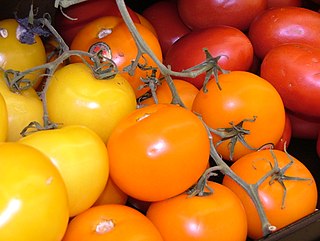
Lycopersicon was a genus in the flowering plant family Solanaceae. It contained about 13 species in the tomato group of nightshades. First removed from the genus Solanum by Philip Miller in 1754, its removal leaves the latter genus paraphyletic, so modern botanists generally accept the names in Solanum. The name Lycopersicon is still used by gardeners, farmers, and seed companies. Collectively, the species in this group apart from the common cultivated plant are called wild tomatoes.
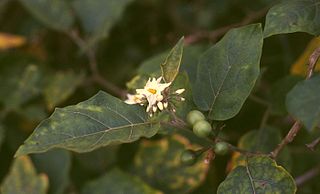
Solanum torvum, also known as pendejera, turkey berry, devil's fig, pea eggplant, platebrush or susumber, is a bushy, erect and spiny perennial plant used horticulturally as a rootstock for eggplant. Grafted plants are very vigorous and tolerate diseases affecting the root system, thus allowing the crop to continue for a second year.
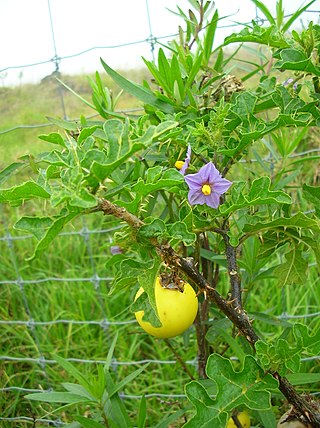
Solanum linnaeanum is a nightshade species known as devil's apple and, in some places where it is introduced, apple of Sodom. The latter name is also used for other nightshades and entirely different plants elsewhere, in particular the poisonous milkweed Calotropis procera.

Solanum elaeagnifolium, the silverleaf nightshade or silver-leaved nightshade, is a common native plant to parts of the southwestern USA, and sometimes weed of western North America and also found in South America. Other common names include prairie berry, silverleaf nettle, white horsenettle or silver nightshade. In South Africa it is known as silver-leaf bitter-apple or satansbos. More ambiguous names include "bull-nettle", "horsenettle" and the Spanish "trompillo".
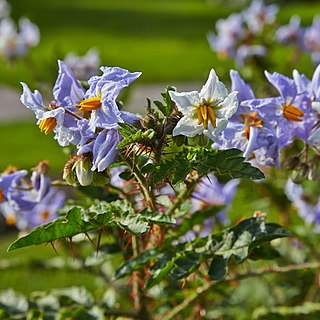
Solanum sisymbriifolium is commonly known as vila-vila, sticky nightshade, red buffalo-bur, the fire-and-ice plant, litchi tomato, or Morelle de Balbis.

Solanum capsicoides, the cockroach berry, known as polohauai'i in Polynesia, is a flowering plant in the family Solanaceae. It is native to eastern Brazil but naturalized in other tropical regions, where it sometimes becomes an invasive weed.
Solanum pseudoquina is a species of plant in the family Solanaceae. It is endemic to Brazil. A rare plant, it is dependent on conservation of its habitat to prevent it from becoming a threatened species.

Solanum paniculatum, commonly known as jurubeba, is a nightshade common in almost all of Brazil. It is used as a medicinal plant and has a bitter taste.

Solanum lanceolatum, with the common names orangeberry nightshade and lanceleaf nightshade, is a species of nightshade. It is native to regions of South America, including the Cerrado ecoregion of the Tropical and subtropical grasslands, savannas, and shrublands biome, primarily in Brazil.

Solanum prinophyllum, known as the forest nightshade, is a small plant native to the east coast of Australia. It is a short lived herb, annual or perennial.
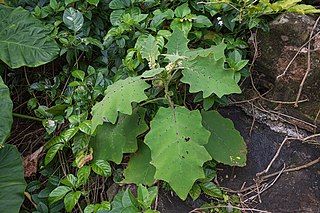
Solanum lasiocarpum, synonym Solanum feroxL., otherwise known as Indian nightshade or hairy-fruited eggplant, is a plant that produces edible fruit. Its flowers are white and its fruits are pale yellow.
















